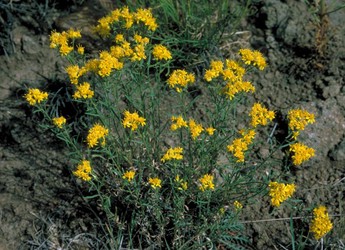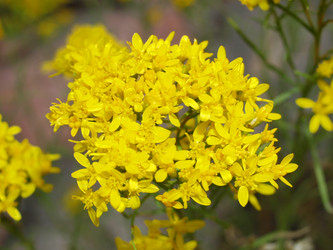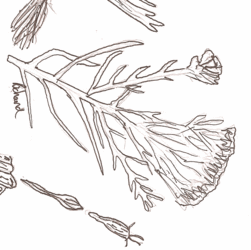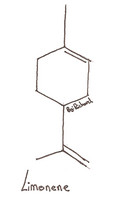Lakota name: peji zizi (yellow herb) Listen to Lakota Plant Name: peji zizi
Listen to Lakota Plant Name: peji zizi
Scientific name: Gutierrezia sarothrae
Common name: Matchbrush, broom snakeweed, snakeweed, terpentine weed, yellow top, kindlingweed, escobilla, yerba-de-vibora, coyaye, matchweed.
Medicinal uses: Boiled for tea, coughing and colds and dizziness. Limonene used in trials for use as a cancer chemotherapeutic agent. Terpentine found in this plant is used as highly effective cure for lice and when mixed with animal fat could be used as a substitute for medicine such as Vick's.
Secondary compounds: This plant has been used for centuries to cure various human ailments and can usually be found in the local herb shops. This plant has 97 volatile compounds that are extracted from the snakeweed’s leaves and steams. The compounds limonene, beta-pinene, beta-eudesmol, sabinene, cryptone, alpha-pinene, and ortho-cymene all have medicinal uses and make up 53% of the volatiles extracted.
Description: This plant is prevalent through the western United States. This plant grows primarily in the spring and summer. A mature plant reaches the height of about a foot and a half. This plant also has high carbon to nitrogen ratio. The flowering part of the plant is yellow and the seeds are brown. It has a moderate lifespan and is slightly toxic. This plant has adapted to fine, medium, and course types of soil. This plant has great durability against the weather. It has a high tolerance against drought and can sustain living in conditions up to -38 degrees F. The roots of this plant grow to a maximum depth of sixteen inches. The blooming period of this plant occurs during the early part of the summer. Its seed abundance is medium and the seed period begins in the summer and ends in the fall. It has a rapid seed dispersal and has 225000 seeds per pound. One plant may produce from 1000 to 22000 seeds per year but is influenced by the land.



Gutierrezia sarothrae. Left: plant © Dave Powell, USDA Forest Service. Right: flowers, photo by Jim Pisarowicz courtesy National Park Service
Distribution: This plant is native to the US and can be found in AZ , CA , CO , ID , KS , MN , MT , NE , NV , NM , NY , ND , OK , OR , SD , TX , UT , WA , WY.
Habitat: Desert and grasslands- native to the Americas, Canada, and Mexico
Similar species: threadleaf snakeweed
Flowering period: Beginning in early summer and ending in the fall
South Dakota distribution: It is found all across South Dakota.




 Go to quick links
Go to quick search
Go to navigation for this section of the ToL site
Go to detailed links for the ToL site
Go to quick links
Go to quick search
Go to navigation for this section of the ToL site
Go to detailed links for the ToL site